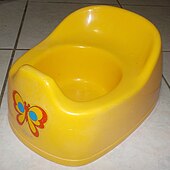Urine deflector
A urine deflector is a device for deflecting the stream of urine during urination. These may be part of a chamber pot, latrine or toilet intended for the purpose, or they may be deterrents. They may be constructed in various ways from a variety of materials but are typically designed to have an angled surface which catches and redirects the stream.
Intentional design[]

Equipment used for toilet training such as a potty chair will typically include a urine deflector to ensure that the urine does not splash forward and outside the receptacle.[1]

Urine Deflectors that fit onto toilet seats help prevent urine from seeping from under the toilet seat.
Military latrines often contain urine deflectors made from sheet metal or tar paper. These would catch and direct the urine into a trough which would carry it to a separate drainage pit. This would minimise the unpleasant smell which typically results from decomposition and production of ammonia[2] and, by keeping the feces drier, allow use of soil to control odors and flies in the main pit. This can also allow incineration. Other designs of latrine typically include similar urine deflectors to prevent degradation of the wooden components and the walls of the pit.[3]
Urine-diverting dry toilets use similar arrangements.
Deterrent[]
Such devices were reported as common in the streets of London in the 19th century.[4] A correspondent to The Farmer's Magazine wrote in 1809,[5]
... in London a man may sometimes walk a mile before he can meet with a suitable corner; for so unaccommodating are the owners of door-ways; passages and angles, that they seem to have exhausted invention in the ridiculous barricadoes and shelves, grooved, and one fixed above another, to conduct the stream into the shoes of the luckless wight who shall dare to profane the intrenchments.
Accurate historical identification of such features is generally more speculative than certain,[6] but potential historical devices have been identified in places such as the Bank of England and Clifford’s Inn Passage.[7][8][9] In other cities such as Vienna, barriers such as iron railings and spikes may have been used to keep people away from attractive corners and crannies.[7][10]
German cities such as Hamburg and Cologne have pioneered the use of hydrophobic paint on walls to deter Wildpinklers. This water-repellent coating causes the stream to rebound at a similar angle and so wet the offender. Other places such as Hackney, Manchester and San Francisco have since evaluated the method for particular trouble spots.[11][12]
Gallery[]

This feature is located in Lothbury, at the Bank of England. Its purpose is not verifiable, but one source identifies it as a urine deflector.[7] The building exterior has no other similar features.

Clifford's Inn Passage

in the Coach and Horses Passage in Newark-on-Trent
References[]
| Wikimedia Commons has media related to Anti urination devices. |
- ^ Taree Bollinger; Patricia Cramer (1985), "Urine deflector", The Baby Gear Guide, Addison-Wesley, p. 153, ISBN 9780201106374
- ^ "Field Sanitation", Seabee Combat Handbook, United States Naval Education and Training Command, 1979, p. 307
- ^ Ernest Franklin Robinson (1917), Military Preparedness and the Engineer: A Handbook for the civilian engineer, p. 304
- ^ Lee Jackson (28 November 2014), Dirty Old London: The Victorian Fight Against Filth, Yale University Press, p. 157, ISBN 9780300210224
- ^ "On Human Exuvia and Soil-Holes", The Farmer's Magazine, Edinburgh: Archibald Constable & Co. (XL): 500, December 1809
- ^ Carly Hacon (12 May 2017), "Retired Norwich teacher's quirky theory about devices to stop people urinating in city streets", Eastern Daily Press
- ^ a b c Roman Mars; Kurt Kohlstedt (2020), "Chapter 6 – Urine Trouble: Discouraging Spikes", The 99% Invisible City: A Field Guide to the Hidden World of Everyday Design, Hodder & Stoughton, ISBN 9781529355307,
An angled urine deflector on the Bank of England building occupies a promising niche...
- ^ "Urine Deflectors of Fleet Street", Atlas Obscura
- ^ Robert Lordan (15 February 2015), "Cabbie's Curios: Victorian Relief", View from the Mirror
- ^ "Anti-Toilets in Vienna and Klosterneuburg", Shadows of a Forgotten World, 25 August 2015
- ^ Gani, Aisha (27 Nov 2015), "Walls that 'pee back' tackle people who urinate in public", The Guardian
- ^ "It's 'peeback' time in Shoreditch and Dalston", , 16 December 2015
- ^ Andy Bull (2019), Secret Ramsgate, Amberley Publishing, p. 35, ISBN 9781445692562
- Sanitation
- Urine



